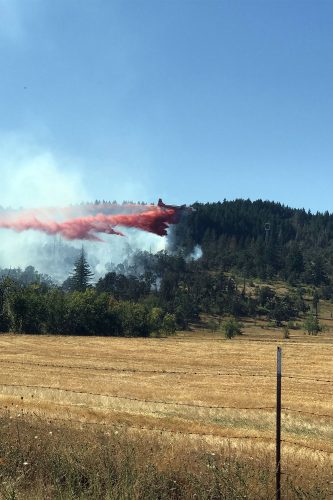
Plant life is thriving at Mount Pisgah Arboretum and Howard Buford Recreation Area after a wildfire engulfed almost 50 acres of the county park in August 2019.
Oak seedlings can be seen sprouting from acorns in the ash and charcoal-laden ground, green leaves grow from the tops of oak trees crisped by the fire and new sprouts are making their appearance at the base of strong and resilient madrone trees.
Despite a widespread belief that fire is inherently all-destructive, the plant life along the southeast side of Mount Pisgah suggests a different perspective. Missing from many conversations about fire are the practices of Indigenous nations who having been living and tending to the land with fire for thousands of years. Maybe fire isn’t inherently bad, after all.
The fire at Mount Pisgah, which erupted shortly after noon Thursday, Aug. 15, was accidental, according to an investigation by the Oregon Department of Forestry. ODF spokeswoman Bobbi Doan said the investigation found the fire erupted when a contractor’s mower hit a rock, sparking the flame.
Brad van Appel, executive director of Mount Pisgah Arboretum, says the contractor was performing regular maintenance at the park, mowing brush that would be used in a few weeks for a prescribed fire.
“They weren’t planning to actually start the fire until conditions changed. This was prep work that was being done weeks in advance,” van Appel says.
Lane County spokesperson Devon Ashbridge says the county follows ODF’s Industrial Fire Precaution Levels within its parks, including its contracted work. She says, “The IFPL level on the day of the wildfire was IFPL II and review afterward indicated that all of the appropriate requirements attached to IFPL II were followed.”
This includes the time of day mowing occurred — between 8 am and 1 pm. Ashbridge says, “While mowing may not be explicitly listed under IFPL II, we tend to take a very restrictive view of allowable activities so that we can reduce risk as much as possible while still performing restoration work that is seasonal in nature.”
Fifteen minutes after the initial spark, the fire covered 400 square feet, about the size of a two-car garage. It quickly grew to eight acres, about the size of seven football fields. The winds carried the fire, nourishing it and moving it upland.
Every fire station east of I-5 was called to the scene; Oregon was having a mild wildfire season and resources were available. In total, four helicopters, three aircraft and 85 firefighters were brought in to put out the fire.
“Approximately 75 percent of the fire’s spread was stopped by nightfall, while crews worked on completing a combination of handline and dozerline around the perimeter of the fire overnight,” ODF’s Doan says.
The park remained closed throughout the weekend; firefighters established full containment by Saturday, Aug. 17.
Combining Indigenous Knowledge and Western Science
“Fire is a natural part of ecology, of nature,” says van Appel of the Arboretum. “The Native Americans were very successful in managing a sustainable ecosystem in this area using fire for thousands of years.”
The Kalapuya tribe of the Willamette Valley, whose ancestral lands include the cities of Eugene and Springfield, used fire management to tend to the land. Typically, fires were burned at low intensity, allowing for the regrowth of native grasses and keeping competition between Douglas-fir and oak trees low, letting the Kalapuya staple food of acorns and camas, prosper.
Kari Norgaard, associate professor of sociology and environmental studies at the University of Oregon, has researched Indigenous fire management practices with the Karuk tribe in Northern California for more than 10 years.
“While fires can be dangerous, they are inevitable and necessary in many ecosystems, and humans have long adapted to them,” she says.
Euro-American settlers were shocked by the rich biodiversity of California and Oregon forests, woodlands and prairies, Norgaard says, but they didn’t understand that Indigenous people’s use of fire was responsible for it. When settlers arrived in the Willamette Valley and forcibly removed Native nations, many tribes, including the Kalapuya people, were outlawed from practicing their traditional ways of fire management.
The Willamette Valley has been in a period of fire suppression for almost 100 years. Norgaard says, “federal, state and local government agencies are starting to increasingly recognize Indigenous burning as an ecosystem component and restoration technique.”
Organizations such as The Nature Conservancy and Friends of Buford Park and Mt. Pisgah have been regularly performing prescribed fires at Mount Pisgah, drawing inspiration from Indigenous communities like the Kalapuya people. Friends of Buford stewards public and private lands outside the Arboretum throughout the 4,700-acre greater Mt. Pisgah area, and TNC works with Lane County and the Friends on a 1,270 acre restoration near Buford.
Because the wildfire occurred in an area that had been a previous prescribed burned spot, van Appel says, “It may have been a benefit in this case since there wasn’t as much dry underbrush as there could have been.”
While parts of the wildfire at Mount Pisgah did burn at high temperatures, killing some non-fire-resistant trees, van Appel says, “Ecologically, there is not really a lot of downsides to the fire. However, socially, economically, you could say there were downsides to the fire.”
As for the future of fire management at Mount Pisgah, van Appel says the window of time in which a contractor performing maintenance and preparing for a prescribed fire may change. Ultimately, he says, “Fire is a natural part of ecology, of nature, [and it] has been a huge part of the history of this landscape for thousands of years.”